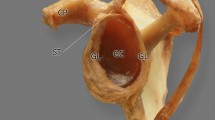Abstract
Introduction
Major anatomical textbooks generally state that the biceps brachii muscle (BB) is composed of long and short heads, whereas the brachialis muscle (BR) consists of a single head. However, the numbers of heads comprising the BB and the BR are very variable. The purpose of this study was to investigate how the branching patterns of the musculocutaneous nerve (MC) influence the number of heads of the BB and the BR.
Materials and methods
Morphological examinations of the BB and MC were conducted using cadavers of 22 Japanese individuals, and morphological examinations of the BR and the MC were conducted in 9 of those 22 individuals.
Results
A three-headed BB was observed in 7 of the 22 specimens (31.8%). Most of these specimens showed a Type III branch pattern (after penetrating the long head or the short head, the MC innervated the supernumerary head or communicated with the main root again). The number of BR heads was categorized into three types: Type A, two heads (superficial and deep heads, 22.2%); Type B, three or four heads (two or three superficial heads and one deep head, 44.4%); and Type C, multiple heads (33.3%). Among these categories, branches of the MC in Type A specimens were most simple.
Conclusion
A supernumerary head of the BB seemed to be present if the MC penetrates it. The BR basically consists of superficial and deep heads, and the number of superficial heads is affected by branches of the MC.











Similar content being viewed by others
References
Koganei Y, Arai S, Shikinami S (1903) Statics of anomaly muscles. Tokyo J Med Sci 17:127–131
Adachi B (1909/1910) Beiträge zur Anatomie der Japaner. Die Statistik der Muskelvarietäten. Zeieschrift für Morphologie Anthropologie 12:261–312
Koizumi K (1934) Studies on the shoulder and brachial muscle. JNMS 5:1063–1083
Ishimi S (1950) Studies on the musculature of the upper extremities of the Japanese fetus. Report on the muscles of the brachium. Igaku Kenkyu 20:766–778
Higashi N, Sone C (1988) A study on the accessory head of the biceps brachii in man. Acta Anat Nippon 63:78–88
Macalister A (1875) Observations on muscular anomalies in the human anatomy. (Third series with a catalogue of the principal muscular variations hitherto published). Trans R Irish Acad Sci 25:1–130
Leonello DT, Galley IJ, Bain GI, Carter CD (2007) Brachialis muscle anatomy. A study in cadavers. J Bone Joint Surg Am 89:1293–1297
Yamamoto M, Hayashi S, Suzuki M, Kimata K, Asamoto K, Nakano T (2013) Brachialis muscle has three heads: consideration for implication in elbow flexion contracture. Rinshokaibou Kenkyu Kiroku 13:20–21
Kosugi K, Shibata S, Yamashita H (1992) Supernumerary head of biceps brachii and branching pattern of the musculocutaneous nerve in Japanese. Surg Radiol Anat 14:175–185
Le Minor JM (1990) A rare variation of the median and musculocutaneous nerves in man. Arch Anat Histol Embryol 73:33–42
Loukas M, Aqueelah H (2005) Musculocutaneous and median nerve connections within, proximal and distal to the coracobrachialis muscle. Folia Morphol (Warsz) 64:101–108
Sunderland S (1978) The musculocutaneous nerve. In: Nerves and nerve injuries, 2nd edn. Churchill Livingstone, Edinburgh, pp 796–801
Yang ZX, Pho RW, Kour AK, Pereira BP (1995) The musculocutaneous nerve and its branches to the biceps and brachialis muscles. J Hand Surg Am 20:671–675
Fener H (1938) Der Nervus Musculocutaneus, seine Verlaufvarianten am Oberarm und deren Beziehung zur Entwicklung eines Caput Tertium Musculi Biciopitis. Z Anat 108:567–586
Koizumi M (1981) A morphological study on the coracobrachialis muscle (in Japanese). Acta Anat Nippon 64:18–35
Hayashi S, Fukuzawa Y, Rodríguez-Vázquez JF, Cho BH, Verdugo-López S, Murakami G, Nakano T (2011) Pleuroperitoneal canal closure and the fetal adrenal gland. Anat Rec (Hoboken) 294:633–44
Niikura H, Jin ZW, Cho BH, Murakami G, Yaegashi N, Lee JK, Lee NH, Li CA (2010) Human fetal anatomy of the coccygeal attachments of the levator ani muscle. Clin Anat 23:566–574
Katori Y, Yamamoto M, Asakawa S, Maki H, Rodríguez-Vázquez JF, Murakami G, Abe S (2012) Fetal developmental change in topographical relationship between the human lateral pterygoid muscle and buccal nerve. J Anat 220:384–395
Abu-Hijleh MF (2005) Three-headed biceps brachii muscle associated with duplicated musculocutaneous nerve. Clin Anat 18:376–379
Lee SH, Jeon JY, Yoon SP (2014) A combined variation of the musculocutaneous nerve associated with a supernumerary head of the biceps brachii muscle. Folia Morphol (Warsz) 73:366–369
Sinnatamby CS (1999) Last’s anatomy. Regional and applied, 10th edn. Churchill Livingstone, Edinburgh
Strandring S (2005) Gray’s anatomy: the anatomical basis of clinical practice, 39th edn. Elsevier Churchill Livingstone, New York
Carlson BM (1994) Human embryology and developmental biology. Mosby, St. Louis, pp 196–197
Yamamoto M, Takayama T, Takata H, Shiraishi Y, Tomita N, Sakanaka K, Murakami G, Rodríguez-Vázquez JF, Abe SI (2016) Coracobrachialis muscle and the musculocutaneous nerve: a study using human embryonic sections. Okajimas Folia Anat Jpn 93:15–20
Bendersky M, Bianchi HF (2012) Double innervation of the brachialis muscle anatomic-physiological study. Surg Radiol Anat 34:865–870
Jones FW (1919) Voluntary muscular movements in cases of nerve lesions. J Anat Lond 54:41–57
Hollinshead WH (1958) Anatomy for surgeons, vol 3. Cassell and Co., London, p 365
Frazer EA, Hobson M, McDonald SW (2007) The distribution of the radial and musculocutaneous nerves in the brachialis muscle. Clin Anat 20:785–789
Cambon-Binder A, Leclercq C (2015) Anatomical study of the musculocutaneous nerve branching pattern: application for selective neurectomy in the treatment of elbow flexors spasticity. Surg Radiol Anat 37:341–348
Thieffry C, Chenin L, Foulon P, Havet E, Peltier J (2017) Microsurgical anatomy of branches of musculocutaneous nerve: clinical relevance for spastic elbow surgery. Surg Radiol Anat 39:773–778
Author information
Authors and Affiliations
Corresponding author
Ethics declarations
Conflict of interest
The authors declare that they have no conflicts of interest.
Rights and permissions
About this article
Cite this article
Yamamoto, M., Kojyo, U., Yanagisawa, N. et al. Morphology and relationships of the biceps brachii and brachialis with the musculocutaneous nerve. Surg Radiol Anat 40, 303–311 (2018). https://doi.org/10.1007/s00276-017-1919-7
Received:
Accepted:
Published:
Issue Date:
DOI: https://doi.org/10.1007/s00276-017-1919-7




